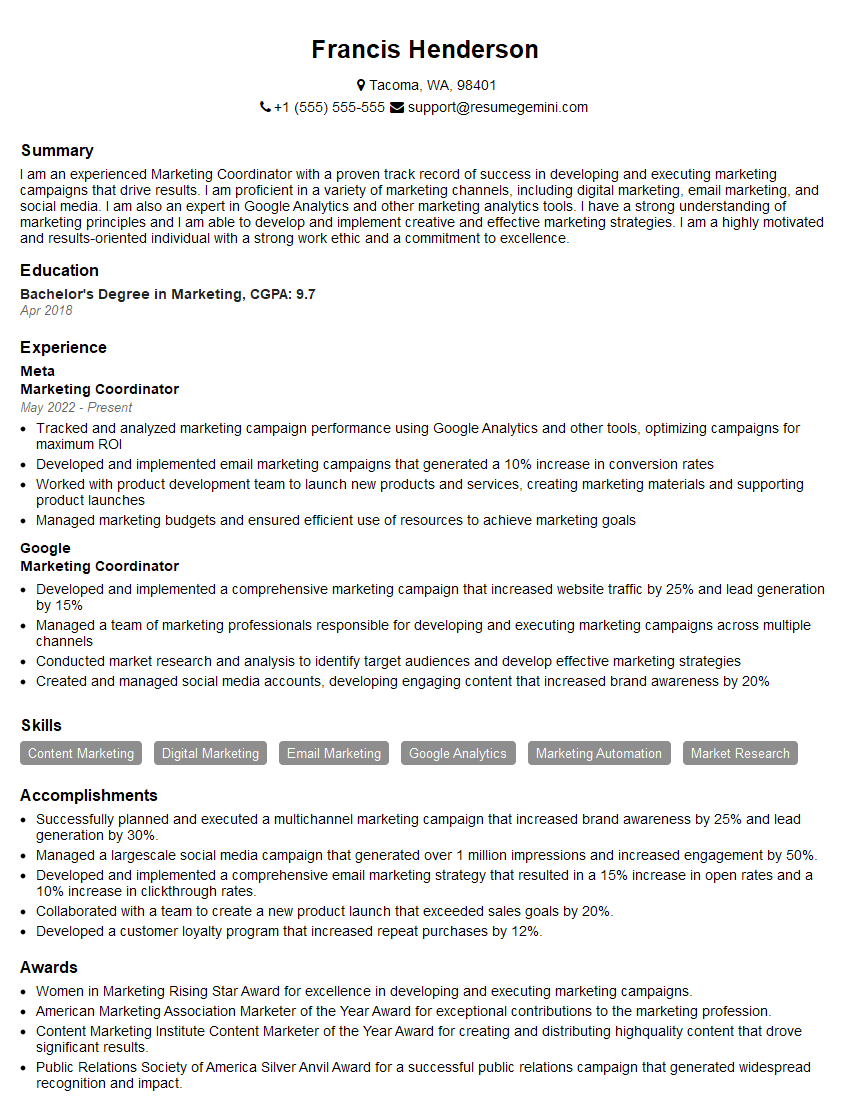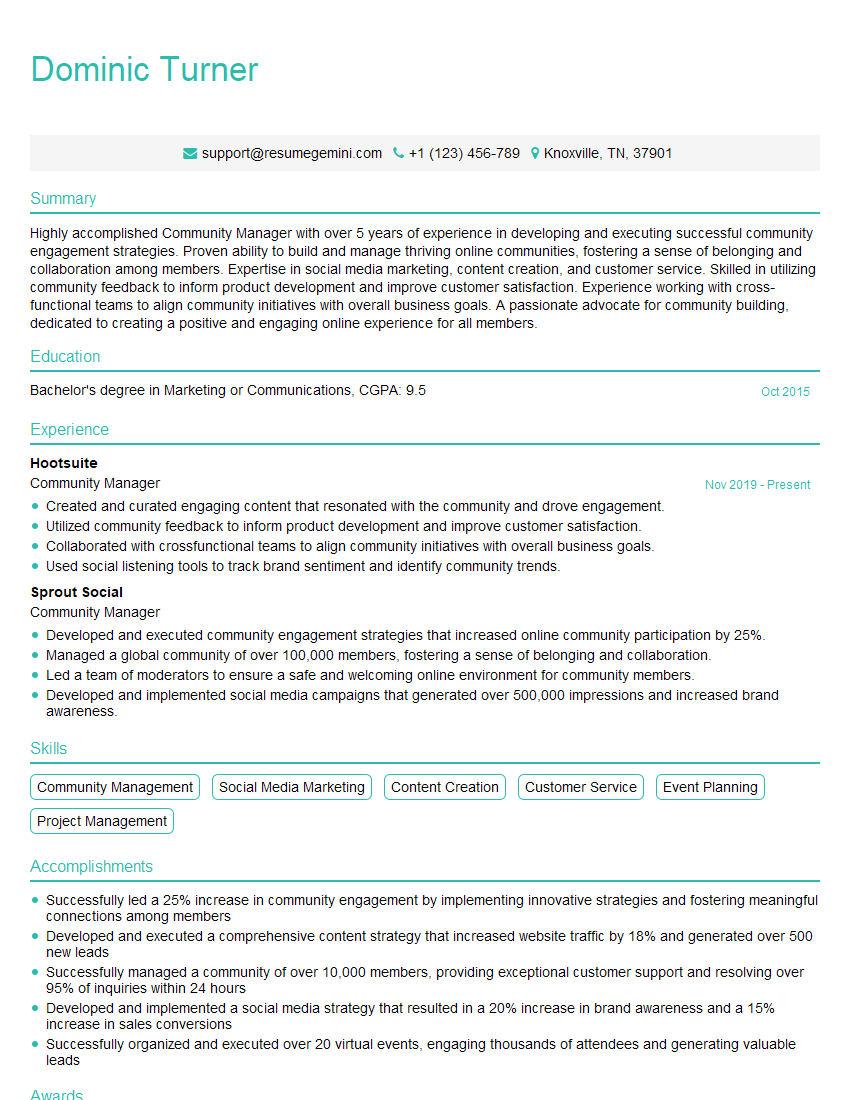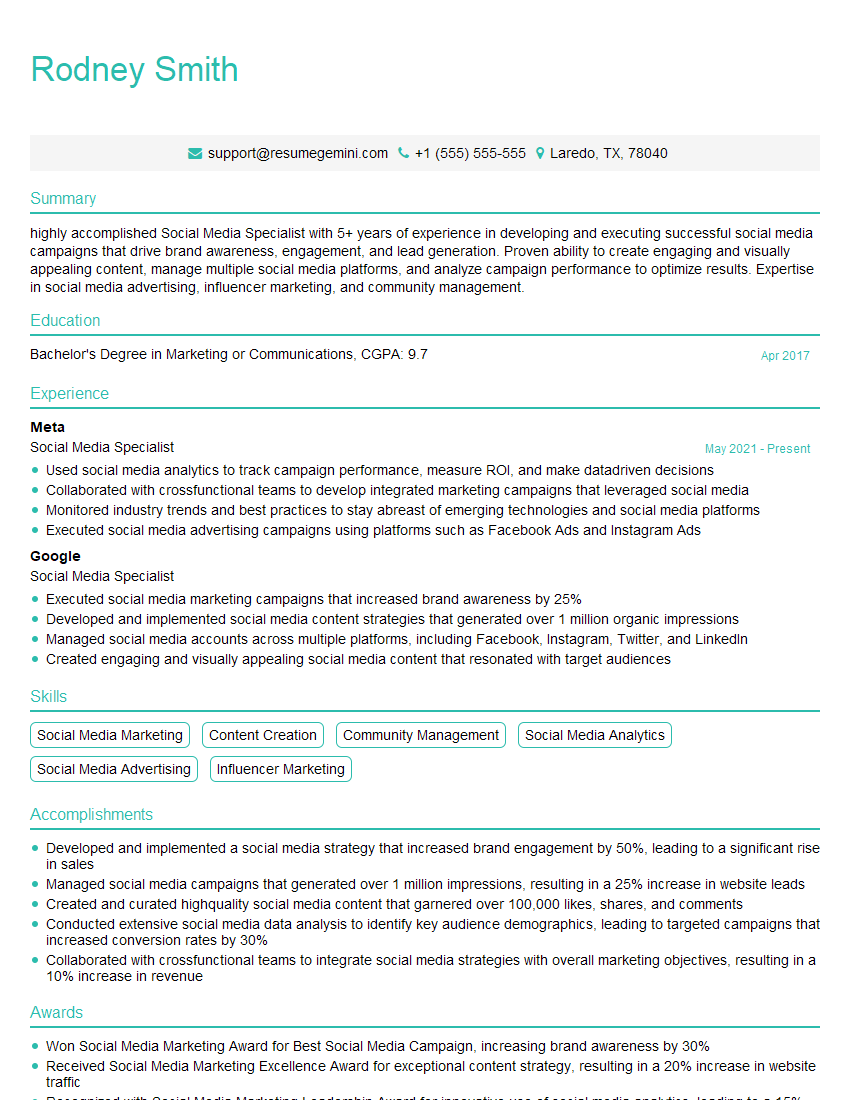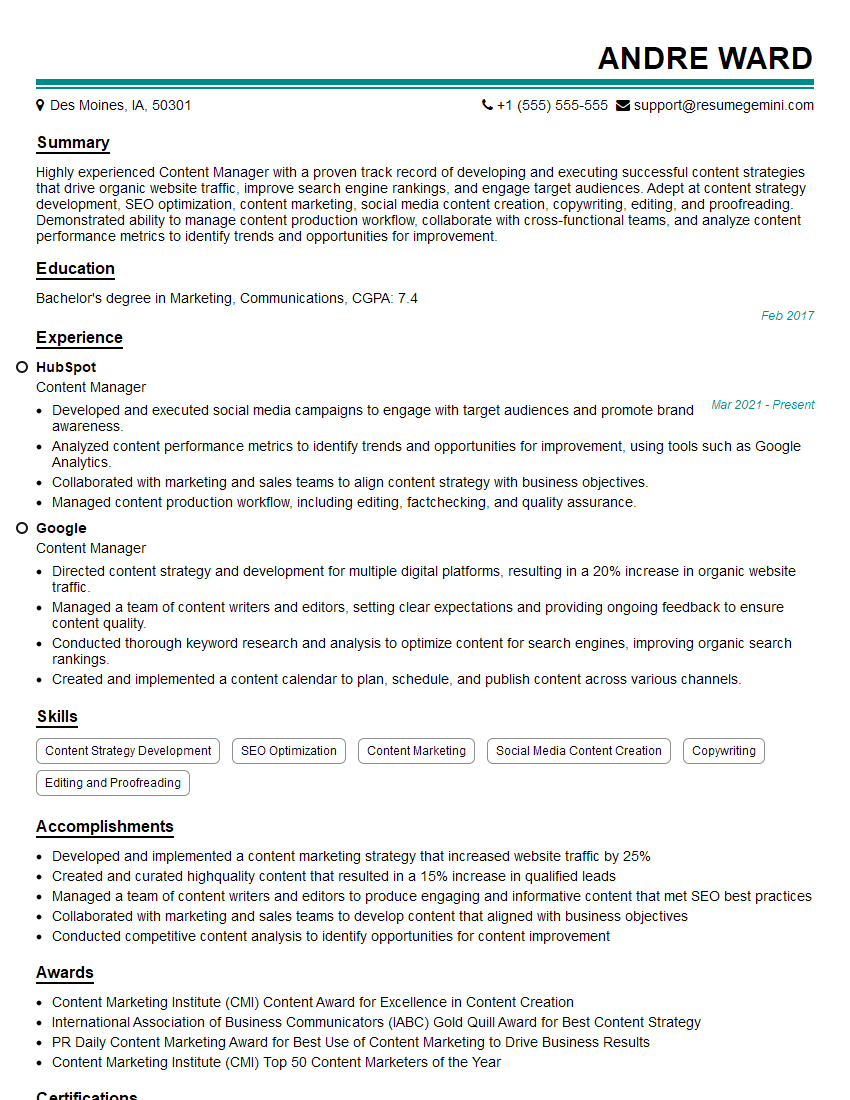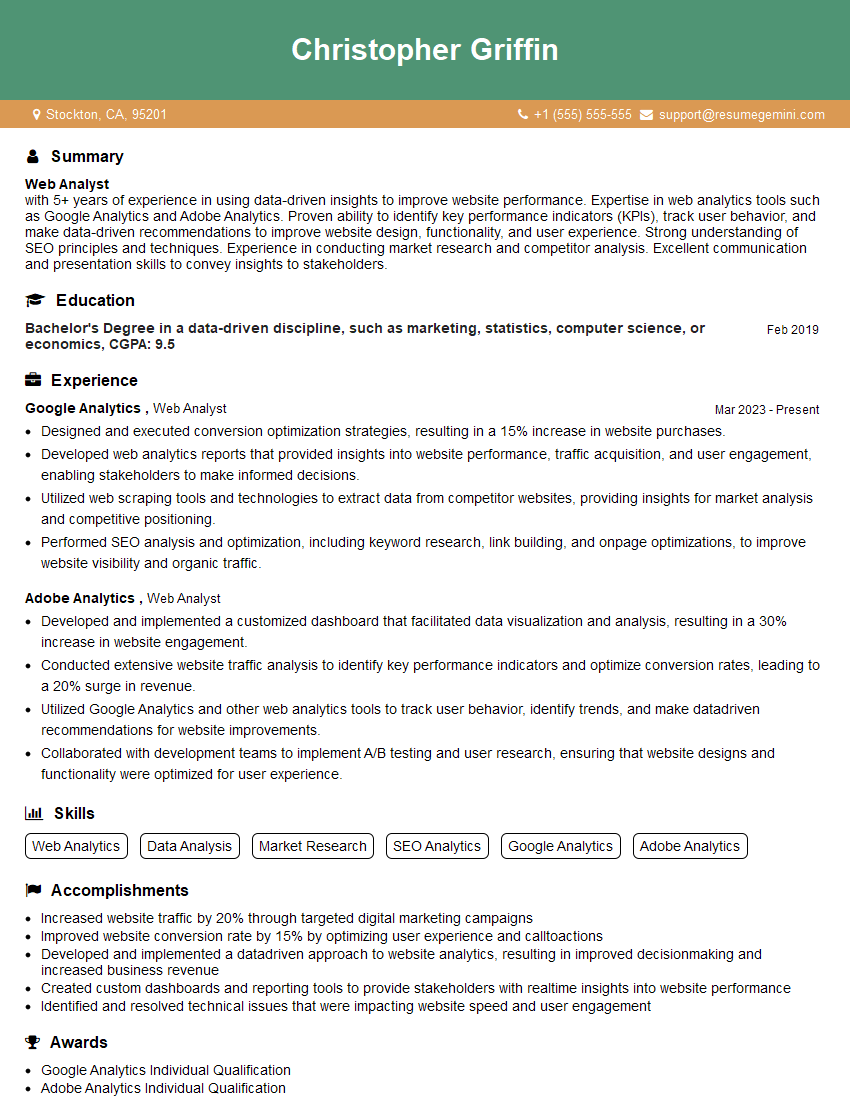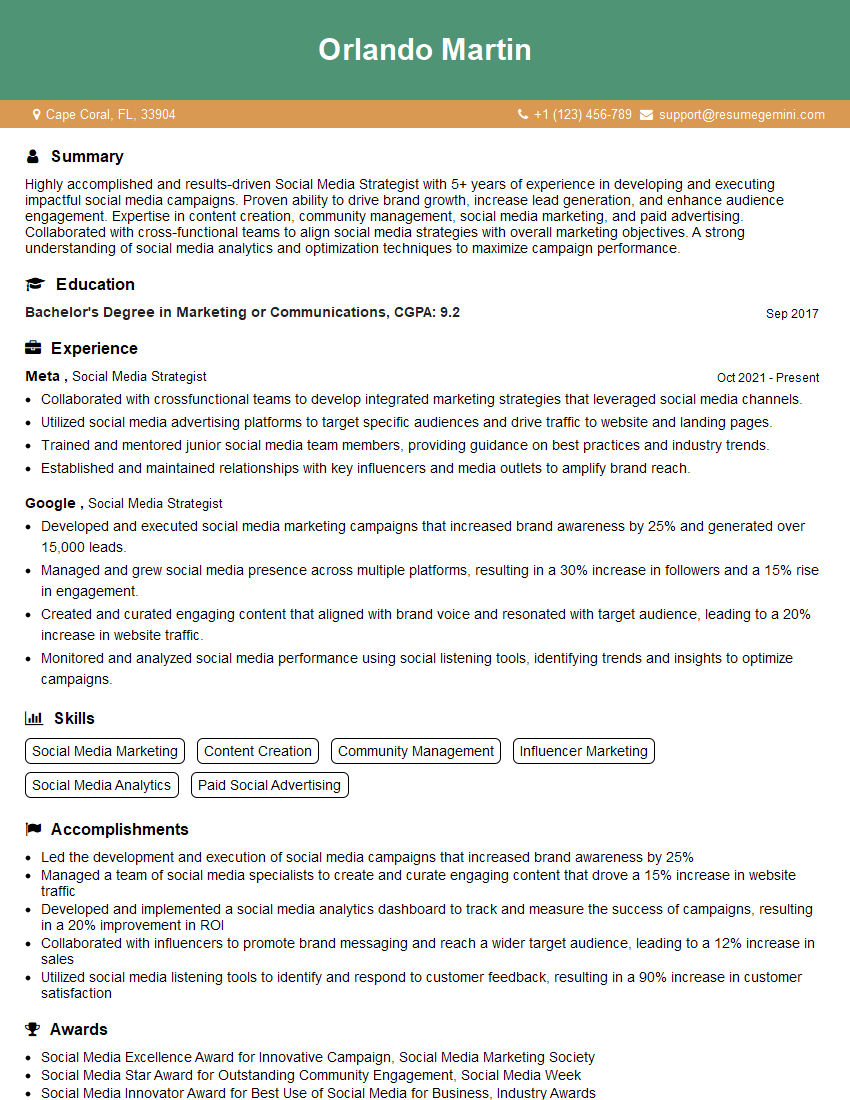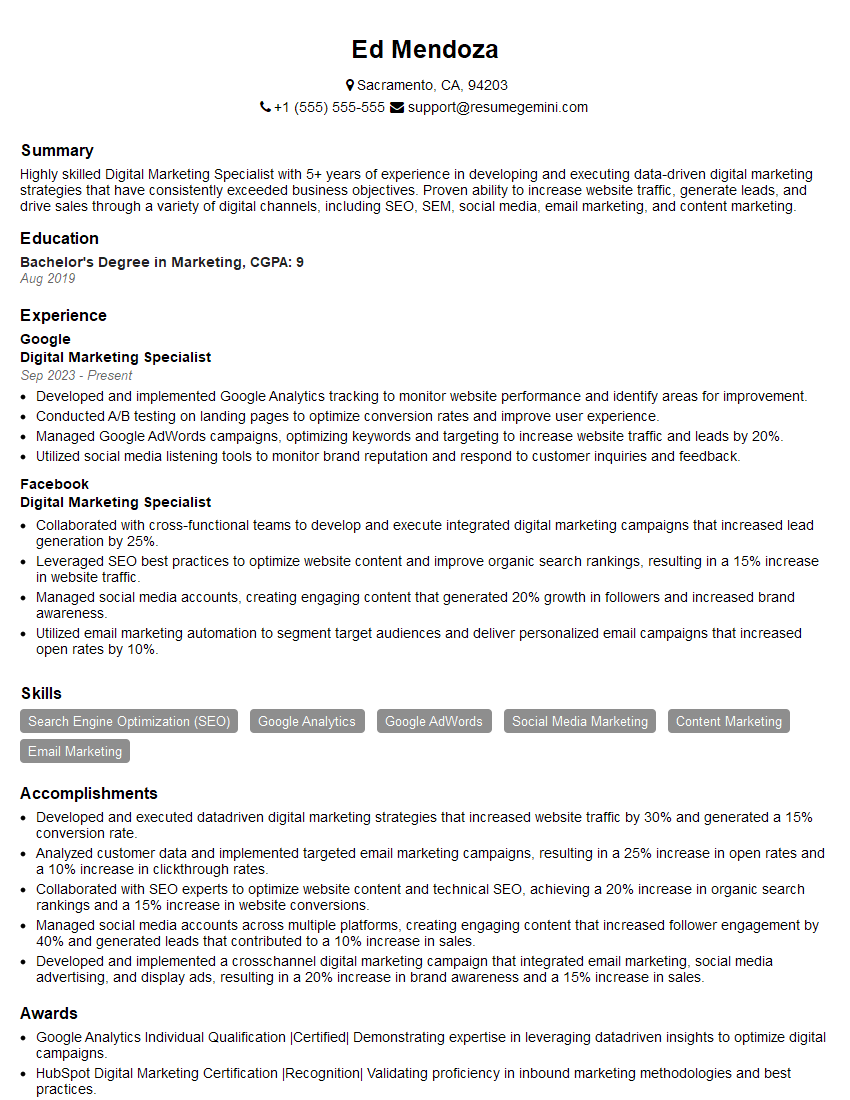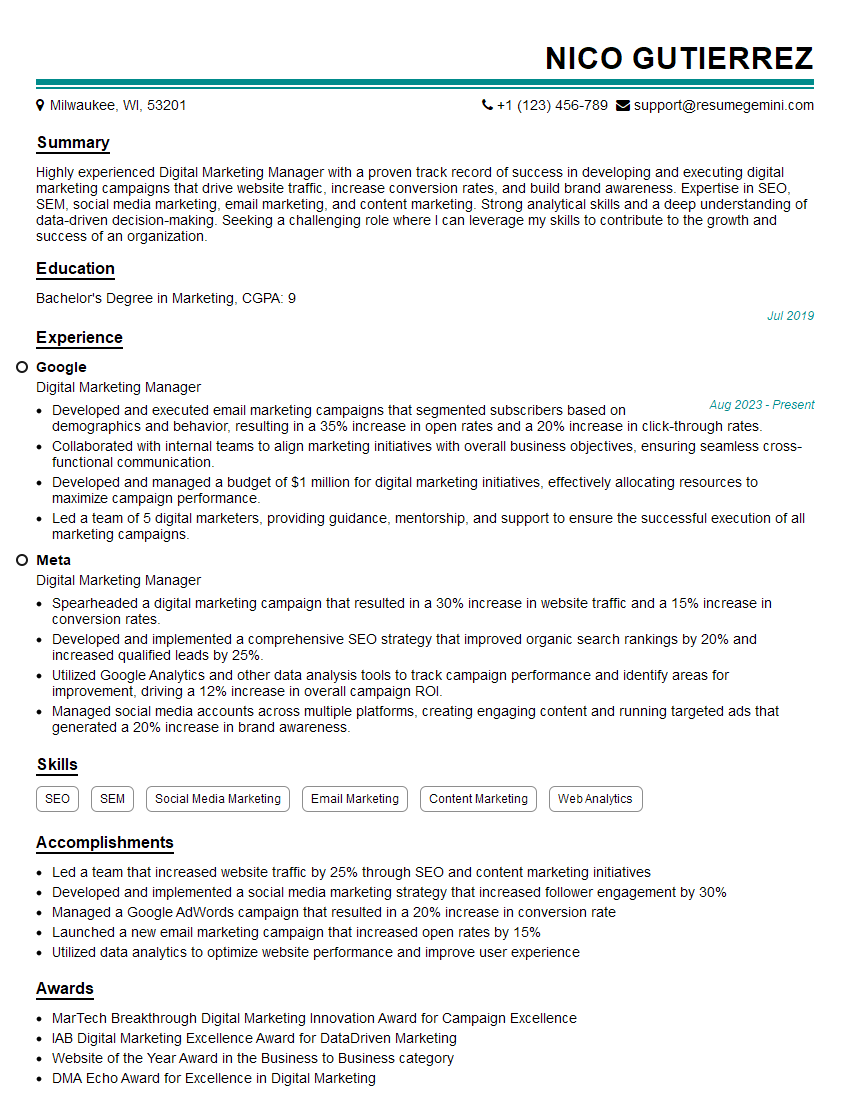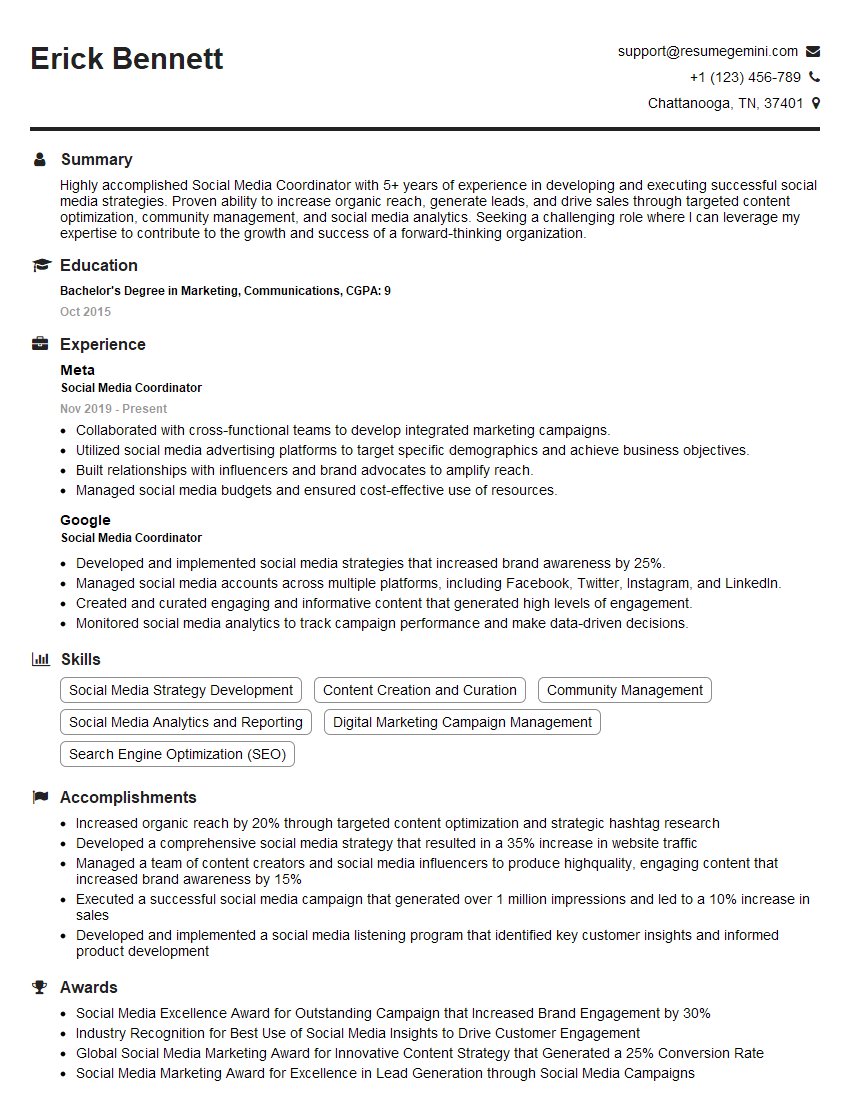Are you ready to stand out in your next interview? Understanding and preparing for Use of Social Media and Technology interview questions is a game-changer. In this blog, we’ve compiled key questions and expert advice to help you showcase your skills with confidence and precision. Let’s get started on your journey to acing the interview.
Questions Asked in Use of Social Media and Technology Interview
Q 1. What are the key performance indicators (KPIs) you track for social media campaigns?
Key Performance Indicators (KPIs) for social media campaigns are crucial for measuring success and making data-driven decisions. They vary depending on campaign goals, but some core KPIs include:
- Reach: The number of unique users who saw your content. This shows the breadth of your campaign’s visibility.
- Engagement: Actions taken by users, like likes, comments, shares, and clicks. High engagement indicates content resonance.
- Website Traffic: The number of users who clicked through from your social media posts to your website. This measures the effectiveness of driving conversions.
- Conversions: The number of desired actions taken, such as purchases, sign-ups, or downloads. This directly reflects campaign ROI.
- Brand Mentions: The number of times your brand is mentioned across social media platforms. This highlights brand awareness and sentiment.
- Click-Through Rate (CTR): The percentage of users who clicked on a link in your post. A high CTR shows compelling content and call-to-actions.
- Cost Per Acquisition (CPA): The cost incurred to acquire one customer through your social media campaigns. Crucial for budget optimization.
For example, a campaign aiming to increase brand awareness might prioritize reach and brand mentions, while a campaign focused on sales would focus on conversions and CPA.
Q 2. Explain your experience with different social media platforms (e.g., Facebook, Instagram, LinkedIn, Twitter, TikTok).
My experience spans various social media platforms, each with its own nuances and target audience:
- Facebook: I’ve managed pages for businesses of all sizes, utilizing targeted advertising to reach specific demographics and interests. I’m proficient in creating engaging content formats, from videos to interactive posts, to maximize reach and engagement. I’ve also utilized Facebook’s analytics tools to track campaign performance and optimize ad spend.
- Instagram: I understand the visual nature of this platform and create visually appealing content that resonates with its audience. I use relevant hashtags, user-generated content, and Instagram Stories to boost engagement. Influencer marketing has been a successful strategy I’ve implemented.
- LinkedIn: This platform is ideal for B2B marketing. I’ve focused on creating professional content, sharing industry insights, and engaging in relevant conversations to build brand credibility and generate leads. I leverage LinkedIn’s advertising features for targeted outreach.
- Twitter: Twitter requires concise and timely communication. I’ve utilized it for real-time engagement, news sharing, customer service, and running contests to build community and drive traffic.
- TikTok: I’ve developed strategies leveraging trending sounds, creative video formats, and engaging challenges to capture attention on this platform. TikTok requires understanding current trends and adapting quickly to remain relevant.
My approach always involves a deep understanding of the platform’s algorithm and target audience to tailor content and strategy for optimal results.
Q 3. Describe your approach to developing a social media strategy for a new product launch.
Developing a social media strategy for a new product launch requires a phased approach:
- Define Goals & KPIs: Clearly define what success looks like (e.g., pre-orders, website traffic, brand awareness). Choose relevant KPIs to track progress.
- Target Audience Research: Identify your ideal customer on each platform. Understand their demographics, interests, and online behavior to tailor your message.
- Content Calendar & Strategy: Create a content calendar that maps out posts across platforms, emphasizing visually appealing content, engaging stories, and interactive elements. Include a mix of informative, entertaining, and promotional content.
- Platform Selection: Choose the platforms where your target audience is most active. Don’t spread your resources too thin.
- Influencer Marketing (Optional): Collaborate with relevant influencers to promote your product to a wider audience.
- Pre-Launch Buzz: Build anticipation before the official launch with teasers, behind-the-scenes content, and contests.
- Launch Day Execution: Coordinate a cohesive launch across all selected platforms. This may include live streams, Q&A sessions, and special offers.
- Post-Launch Monitoring & Optimization: Track KPIs, analyze results, and adjust your strategy based on performance data. Iterate continuously to improve results.
For example, launching a new fitness app, I’d prioritize Instagram and TikTok for visually-driven content, and Facebook and LinkedIn for targeted advertising and community building.
Q 4. How do you measure the ROI of social media marketing efforts?
Measuring the ROI of social media marketing isn’t straightforward. It requires a multi-faceted approach:
- Attribution Modeling: Track the customer journey from initial social media engagement to conversion. This helps determine which social media actions directly led to sales.
- Website Analytics Integration: Utilize tools like Google Analytics to track website traffic originating from social media. This helps assess the effectiveness of driving traffic and conversions.
- Conversion Tracking: Implement conversion tracking pixels on your website to monitor specific actions, like purchases or sign-ups, that are directly attributable to social media campaigns.
- Brand Awareness Metrics: While difficult to quantify directly, track brand mentions, reach, and engagement to gauge the impact on brand visibility and sentiment.
- Qualitative Analysis: Analyze customer feedback and comments to understand the impact of your social media efforts on brand perception.
A simple formula to estimate ROI is: (Revenue generated from social media - Social media marketing cost) / Social media marketing cost * 100%. However, this doesn’t fully account for brand building and long-term benefits.
Q 5. What tools and technologies do you use for social media management and analytics?
I use a suite of tools for social media management and analytics:
- Hootsuite/Buffer: For scheduling and managing posts across multiple platforms. This saves time and ensures consistent posting.
- Sprout Social/Later: For social listening, community management, and analytics dashboards. These tools offer insights into audience behavior and campaign performance.
- Google Analytics: To track website traffic from social media and analyze user behavior.
- Social Media Platform Analytics: Each platform offers its own analytics dashboard, providing valuable data on post performance and audience demographics.
- Brand24/Mention: For monitoring brand mentions and social listening to identify emerging trends and address customer concerns.
The specific tools I use depend on the client’s needs and budget. Data integration between these tools is vital for a holistic view of social media performance.
Q 6. How do you handle negative comments or feedback on social media?
Handling negative comments requires a calm and professional approach:
- Respond Promptly: Address negative comments within a reasonable timeframe. Ignoring them can make the situation worse.
- Acknowledge the Feedback: Show empathy and understanding. Begin by acknowledging the user’s concerns and thanking them for their feedback.
- Take Ownership (if applicable): If the criticism is valid, take responsibility and apologize for the issue. Outline steps taken to address the concern.
- Offer a Solution: Attempt to resolve the issue privately, offering a solution or compensation where appropriate. Moving the conversation offline can sometimes help.
- Maintain Professionalism: Always maintain a professional and respectful tone, even when faced with aggressive comments. Avoid getting into arguments or engaging in personal attacks.
- Document Everything: Keep a record of all negative comments and how they were handled for future reference.
Transparency and a genuine effort to resolve issues are key to mitigating negative publicity and building trust.
Q 7. Explain your understanding of social media algorithms and how they impact reach.
Social media algorithms are complex systems that determine which content users see. They prioritize content based on various factors, significantly impacting reach:
- Engagement: Posts with high engagement (likes, comments, shares) are more likely to be shown to a wider audience. Algorithms reward content that generates interaction.
- Relevance: Algorithms prioritize content relevant to a user’s interests and past behavior. This explains why you see content related to your searches and previous engagements.
- Timeliness: Recent posts are generally prioritized over older ones. Staying active and posting frequently is important for visibility.
- Account Quality: Accounts with a history of positive engagement and adherence to platform policies are favored.
- Relationships: Algorithms consider the connections between users and accounts. Content from followed accounts and friends is often prioritized.
Understanding these factors is crucial for optimizing content and maximizing reach. Strategies like using relevant hashtags, creating high-quality content, and engaging with your audience directly contribute to increased visibility.
Q 8. How do you stay up-to-date on the latest social media trends and best practices?
Staying current in the ever-evolving landscape of social media requires a multi-faceted approach. It’s not enough to simply scroll through your feed; you need a proactive strategy.
- Industry Publications and Blogs: I regularly read publications like Social Media Today, Marketing Land, and Hubspot’s marketing blog. These offer in-depth analyses of trends, algorithm changes, and best practices.
- Social Media Listening Tools: Tools like Brandwatch and Talkwalker provide real-time insights into what people are saying about brands and topics within my industry. This allows me to identify emerging trends before they become mainstream.
- Following Key Influencers and Experts: I actively follow thought leaders on platforms like Twitter and LinkedIn. Their posts, webinars, and podcasts provide invaluable insights and fresh perspectives.
- Competitor Analysis: I analyze the strategies of competitors and industry leaders to understand what’s working and what isn’t. This isn’t about copying; it’s about gaining inspiration and identifying opportunities.
- Attending Industry Events and Webinars: Conferences and online webinars provide a fantastic opportunity for networking and learning from experts in the field. They often offer insights not readily available elsewhere.
This combined approach ensures I’m not just reactive but proactive in adapting to the changing social media landscape. For example, the recent rise of short-form video content on platforms like TikTok and Instagram Reels was quickly identified through these channels, prompting an immediate adjustment in our content strategy.
Q 9. Describe your experience with paid social media advertising.
My experience with paid social media advertising spans several years and various platforms. I’ve managed campaigns across Facebook, Instagram, Twitter, and LinkedIn, focusing on diverse objectives, from brand awareness to lead generation and driving e-commerce sales.
I’m proficient in utilizing platform-specific advertising tools to create highly targeted campaigns. This includes defining audience demographics, interests, and behaviors; crafting compelling ad creatives; A/B testing different variations; and analyzing campaign performance using key metrics like click-through rates (CTR), cost per acquisition (CPA), and return on ad spend (ROAS).
For instance, in a recent campaign for an e-commerce client, we used Facebook’s dynamic product ads to retarget website visitors. This highly personalized approach significantly boosted conversion rates. We also leveraged LinkedIn’s detailed targeting options to reach professionals within specific industries for B2B lead generation. Throughout each campaign, I meticulously track and optimize performance, constantly refining strategies to maximize ROI.
My expertise extends to managing budgets effectively and ensuring campaign compliance with platform policies.
Q 10. How do you create engaging and shareable social media content?
Creating engaging and shareable social media content requires a deep understanding of your target audience and the platform’s nuances. It’s about storytelling, not just selling.
- Know Your Audience: Understanding their needs, interests, and preferred content formats is paramount. Are they visual learners who respond to high-quality images and videos? Or do they prefer informative, text-based posts?
- High-Quality Visuals: Compelling visuals are key. Invest in professional photography or videography whenever possible. Ensure your images and videos are visually appealing and relevant to your message.
- Storytelling: Craft narratives that resonate with your audience. Connect with them on an emotional level and offer value. Don’t just promote your product or service; tell a story about how it solves a problem or improves lives.
- Interactive Content: Polls, quizzes, Q&As, and contests can significantly increase engagement. Encourage participation and foster a sense of community.
- Consistent Branding: Maintain a consistent brand voice, tone, and visual identity across all your social media platforms.
- Strategic Use of Hashtags: Research relevant hashtags to increase discoverability. Don’t overdo it; choose a strategic mix of popular and niche hashtags.
For example, instead of simply posting a picture of a product, we might create a behind-the-scenes video showing the craftsmanship that goes into making it, highlighting the human element and building brand trust.
Q 11. How do you identify and target your ideal audience on social media?
Identifying and targeting the ideal audience is crucial for successful social media marketing. It’s about reaching the right people with the right message at the right time.
- Define Your Ideal Customer Profile (ICP): Develop a detailed understanding of your target audience’s demographics, psychographics (interests, values, lifestyle), behaviors, and online habits. Consider factors like age, gender, location, income, profession, and online activity.
- Leverage Platform-Specific Targeting Options: Utilize the advanced targeting options available on each social media platform (e.g., Facebook’s detailed targeting, Twitter’s interest-based targeting). These options allow you to reach highly specific audience segments based on your ICP.
- Utilize Social Listening: Monitoring social media conversations and analyzing online discussions helps identify your target audience’s needs, pain points, and preferences. This information can be invaluable for refining your targeting and messaging.
- Analyze Your Existing Customer Base: If you have an established customer base, analyze their demographics and online behavior to gain a better understanding of your ideal customer.
- A/B Testing: Experiment with different targeting parameters and messaging to identify what resonates best with your audience.
For example, a B2B SaaS company might target LinkedIn users with specific job titles and industry affiliations, while a consumer-facing brand might target Facebook users based on their interests and demographics.
Q 12. What is your experience with social listening and monitoring tools?
Social listening and monitoring tools are essential for understanding public perception, identifying brand mentions, tracking trends, and responding to customer feedback in real-time. I have extensive experience using various tools to achieve these objectives.
I’ve worked with tools such as Brandwatch, Sprout Social, and Hootsuite. These platforms allow for comprehensive social media monitoring, enabling me to track brand mentions, sentiment analysis (positive, negative, neutral), identify influencers discussing the brand, and monitor competitor activity. This helps in proactively addressing negative feedback, spotting emerging crises, and identifying opportunities to engage with potential customers.
For example, using sentiment analysis, we discovered a negative trend regarding a specific product feature. This allowed us to address customer concerns proactively through targeted communications and product improvements, preventing a potential PR crisis. The data generated from these tools is crucial for informed decision-making, content strategy adjustments, and overall campaign optimization.
Q 13. Describe a time you had to adapt your social media strategy due to unexpected circumstances.
During the initial stages of the COVID-19 pandemic, we had to adapt our social media strategy for a client in the hospitality industry almost overnight. Their business, like many others, was severely impacted by lockdowns and travel restrictions.
Our initial strategy focused on promoting special offers and driving bookings. However, with travel virtually impossible, this approach became irrelevant and potentially tone-deaf. We quickly pivoted to a strategy that focused on building community and offering emotional support.
We shifted to creating engaging content that highlighted the client’s commitment to safety and future reopening plans. We shared heartwarming stories from past guests and encouraged online engagement through contests and virtual tours. This empathetic approach not only helped maintain brand visibility but also fostered customer loyalty during an extremely challenging period. It demonstrated that we could adapt swiftly and strategically respond to major unforeseen events.
Q 14. Explain your experience working with influencer marketing campaigns.
Influencer marketing has become a vital part of many successful social media strategies. My experience involves identifying relevant influencers, negotiating partnerships, managing campaigns, and measuring results.
I typically start by defining campaign goals and identifying key performance indicators (KPIs) such as reach, engagement, and website traffic. Then, I meticulously research potential influencers who align with our brand values and target audience. This includes assessing their audience demographics, engagement rates, and overall brand reputation.
Once a selection of influencers is made, I develop campaign briefs outlining content requirements, timelines, and brand guidelines. I also negotiate contracts and monitor performance throughout the campaign, analyzing metrics to gauge its effectiveness. It’s not just about selecting influencers with large follower counts; it’s about finding those who genuinely connect with their audience and can authentically promote the brand. I regularly analyze influencer performance and adjust our strategies as needed to optimize results.
For example, in a recent campaign, we partnered with micro-influencers (those with smaller but highly engaged audiences) to promote a new product line. This targeted approach yielded higher engagement rates and a better return on investment than working with just a few macro-influencers (those with millions of followers).
Q 15. How do you ensure brand consistency across all social media platforms?
Maintaining brand consistency across all social media platforms is crucial for building a strong and recognizable brand identity. It’s about ensuring your messaging, tone, visuals, and overall aesthetic are uniform, regardless of the platform. Think of it like a well-orchestrated symphony – each instrument (social media platform) plays a different part, but they all contribute to the same harmonious whole (your brand).
- Develop a Style Guide: This is your bible. It outlines your brand’s voice (formal, informal, humorous?), color palette, font choices, logo usage, and image style. For example, if your brand is playful, your style guide might encourage the use of GIFs and memes, while a more professional brand would opt for polished photography and infographics.
- Centralized Content Creation: Create content in a central repository, then adapt it for each platform. Instead of writing separate posts for Facebook, Instagram, and Twitter, craft a core message and then tailor it to the specific platform’s character limits and audience expectations.
- Regular Audits: Schedule regular reviews of your social media presence to ensure everything aligns with your style guide. Identify any inconsistencies and rectify them promptly. Imagine a fashion brand suddenly using a completely different logo on Instagram; that’s a brand consistency nightmare!
- Utilize Social Media Management Tools: Tools like Hootsuite or Buffer allow you to schedule and publish content across multiple platforms simultaneously, helping maintain consistency and save time.
Career Expert Tips:
- Ace those interviews! Prepare effectively by reviewing the Top 50 Most Common Interview Questions on ResumeGemini.
- Navigate your job search with confidence! Explore a wide range of Career Tips on ResumeGemini. Learn about common challenges and recommendations to overcome them.
- Craft the perfect resume! Master the Art of Resume Writing with ResumeGemini’s guide. Showcase your unique qualifications and achievements effectively.
- Don’t miss out on holiday savings! Build your dream resume with ResumeGemini’s ATS optimized templates.
Q 16. What is your understanding of SEO and its role in social media marketing?
SEO, or Search Engine Optimization, is the practice of increasing the quantity and quality of traffic to your website through organic search engine results. While primarily associated with websites, SEO principles extend to social media marketing, enhancing your brand’s visibility and reach.
Here’s how SEO plays a role in social media marketing:
- Keyword Optimization: Using relevant keywords in your social media posts and descriptions improves the chances of your content appearing in search results. For instance, a bakery might use keywords like “best croissants,” “local bakery,” or “artisan bread” in their posts.
- Link Building: Linking your social media profiles to your website and vice-versa creates a network of interconnected content, boosting your website’s SEO and driving traffic to both.
- High-Quality Content: Creating engaging and valuable content that people want to share organically increases your brand’s visibility and reputation. This also indirectly improves SEO by increasing backlinks and mentions.
- Brand Mentions: Monitoring brand mentions and responding to them strengthens your online presence and can indirectly influence SEO through improved brand reputation and increased website traffic.
Q 17. Explain your experience with content scheduling and automation tools.
I have extensive experience with content scheduling and automation tools, using them to streamline workflows and maximize efficiency. These tools are invaluable for maintaining a consistent social media presence without constantly being glued to the screen. Think of them as your social media assistants.
I’ve worked with tools like:
- Hootsuite: A comprehensive platform for managing multiple social media accounts, scheduling posts, monitoring mentions, and analyzing data.
- Buffer: Another popular tool known for its user-friendly interface and features like team collaboration and content curation.
- Sprout Social: A powerful platform offering robust analytics and social listening capabilities, in addition to scheduling and publishing tools.
Using these tools, I’ve successfully implemented strategies like:
- Content Calendars: Planning content in advance ensures a consistent posting schedule, allowing for thematic campaigns and timely relevance.
- Automated Posting: Scheduling posts in advance frees up time for other crucial tasks like community engagement and data analysis.
- A/B Testing: Using scheduling tools allows for easy A/B testing of different content types and posting times to optimize engagement.
Q 18. How do you analyze social media data to identify trends and insights?
Analyzing social media data is vital for understanding audience engagement and campaign performance. It’s like having a magnifying glass on your audience’s preferences and reactions. I use a multi-faceted approach:
- Platform-Specific Analytics: Each social media platform (Facebook, Instagram, Twitter, etc.) provides its own analytics dashboard. I leverage these to track metrics like reach, engagement (likes, comments, shares), follower growth, and website clicks.
- Social Listening Tools: Tools like Brandwatch or Talkwalker allow me to monitor brand mentions and sentiment across various social media platforms. This helps identify trends, emerging issues, and customer feedback.
- Data Visualization: I use tools like Google Data Studio or Tableau to create visually appealing dashboards that make complex data easy to understand and share with stakeholders. A picture is worth a thousand data points, after all.
- Key Metrics: I focus on key metrics relevant to business goals. For example, if the goal is lead generation, I’ll closely monitor website clicks from social media. If it’s brand awareness, I’ll look at reach and impressions.
By analyzing this data, I can identify trends such as the best time to post, the most engaging content formats, and the topics that resonate most with the audience. This allows for data-driven decision-making and continuous improvement of social media strategies.
Q 19. How do you collaborate with other teams (e.g., sales, product development) to support social media goals?
Collaboration is key to achieving social media goals. Social media isn’t an isolated function; it intersects with sales, product development, and other teams.
My approach to collaboration includes:
- Regular Meetings: I participate in regular meetings with relevant teams to align social media strategies with overall business objectives. For example, I’ll work with the sales team to coordinate social media campaigns that support their sales initiatives.
- Shared Goals and KPIs: I work with other teams to define shared goals and key performance indicators (KPIs) to ensure everyone is working towards the same outcome. This promotes a sense of shared ownership and accountability.
- Feedback Loops: I establish clear feedback mechanisms to incorporate insights from other teams into my social media strategy. For example, I’ll work with the product team to ensure social media content reflects the features and benefits of new product launches.
- Cross-Functional Projects: I actively participate in cross-functional projects, contributing my expertise in social media to enhance the overall impact of marketing campaigns and product launches.
Q 20. What is your experience with social media analytics platforms (e.g., Google Analytics, Sprout Social)?
I’m proficient in using various social media analytics platforms to gain insights into campaign performance and audience behavior. These platforms offer a wealth of data, but understanding how to interpret it effectively is crucial.
My experience includes:
- Google Analytics: I use Google Analytics to track website traffic originating from social media, enabling me to measure the effectiveness of social media campaigns in driving website conversions.
- Sprout Social: I utilize Sprout Social’s comprehensive analytics dashboard to track engagement metrics, sentiment analysis, and competitor activity. This holistic view provides a richer understanding of the social media landscape.
- Native Platform Analytics: As mentioned earlier, I leverage the built-in analytics dashboards of each social media platform (Facebook Insights, Instagram Insights, Twitter Analytics) to analyze platform-specific data and optimize content accordingly.
I’m adept at extracting actionable insights from these platforms and translating them into strategies for improved campaign performance and audience engagement.
Q 21. How familiar are you with different social media advertising platforms?
I possess a strong understanding of various social media advertising platforms and have experience managing campaigns across different channels. The right platform depends heavily on the target audience and campaign objectives.
- Facebook Ads Manager: Highly proficient in creating and managing campaigns on Facebook, targeting specific demographics, interests, and behaviors. I understand the nuances of Facebook’s auction system and optimization techniques.
- Instagram Ads Manager: Experienced in leveraging Instagram’s visual-focused platform to reach audiences through image and video ads. I understand how to create visually appealing campaigns that resonate with the Instagram audience.
- Twitter Ads: Familiar with using Twitter’s promoted tweets and trends to reach targeted audiences and increase brand awareness. I know how to effectively utilize Twitter’s unique features, such as hashtags and trending topics, to increase campaign visibility.
- LinkedIn Ads: Experienced in leveraging LinkedIn’s professional network to target business professionals and generate leads. I understand how to craft effective campaigns that speak to the specific needs and interests of this audience.
- Google Ads (for YouTube and Display): I can also leverage Google Ads to reach audiences through YouTube video ads and display ads across the Google Display Network, creating a multi-channel approach to digital marketing.
My approach is always data-driven. I use A/B testing and continuous monitoring to optimize ad campaigns for maximum ROI.
Q 22. Describe your experience with A/B testing social media content and ads.
A/B testing is crucial for optimizing social media performance. It involves creating two or more versions of a post or ad (A and B), each with a slightly different element – headline, image, call to action – and then analyzing which performs better based on metrics like click-through rate (CTR), engagement, and conversions. I have extensive experience designing and implementing A/B tests across various platforms like Facebook, Instagram, and Twitter. For example, I once tested two different ad creatives for a client promoting a new product. One featured a lifestyle image, the other focused on product specifications. The A/B test revealed the lifestyle image significantly outperformed the product-focused ad in terms of engagement and click-throughs, guiding our future campaign strategy. I typically use the platform’s built-in A/B testing tools, ensuring proper randomization and sufficient sample sizes for reliable results. Post-test analysis involves carefully reviewing the data and drawing actionable insights to refine future campaigns.
Q 23. How do you manage multiple social media accounts simultaneously?
Managing multiple social media accounts efficiently requires a strategic approach and the right tools. I utilize social media management platforms like Hootsuite or Buffer to schedule posts, monitor mentions, and engage with audiences across different platforms simultaneously. This allows for centralized content creation and scheduling, saving significant time and ensuring a consistent brand voice across all channels. For example, I might schedule a series of tweets announcing a product launch on Twitter, simultaneously posting a related Instagram story and a Facebook post with a longer-form description. Beyond scheduling tools, I also implement a content calendar to plan content in advance and ensure that content aligns with overall marketing objectives. This organized approach helps me maintain a consistent social media presence across all platforms without feeling overwhelmed.
Q 24. How do you ensure compliance with social media policies and guidelines?
Compliance with social media policies and guidelines is paramount. My approach is proactive and involves staying updated on the latest terms of service and community standards of each platform. This includes regular review of platform updates and changes to their policies. I meticulously review all content before publishing to ensure it aligns with the brand’s guidelines, legal requirements, and the platform’s rules, avoiding issues like copyright infringement or misleading advertising. For example, I carefully consider the use of user-generated content, always ensuring I have permission before reposting. I also implement robust moderation strategies to address inappropriate comments or content, responding promptly and appropriately to maintain a positive and respectful online environment. Regular internal audits and training sessions further enhance our team’s understanding of compliance requirements.
Q 25. What is your experience with social media crisis management?
Social media crisis management requires a swift and decisive response. My experience includes developing and implementing crisis communication plans. These plans detail how to identify, assess, and respond to negative situations efficiently. This includes establishing clear communication channels, identifying key stakeholders, and pre-approving messaging to ensure consistent responses. During a crisis, the first step is to acknowledge the issue promptly and empathetically, demonstrating a commitment to resolving the situation. Next, I gather information to understand the scope of the problem and craft transparent and honest communication. For instance, if a negative review goes viral, I would investigate the complaint, address the issue directly (publicly if necessary), and offer a fair resolution. Transparency and timely action are vital in mitigating damage and restoring trust. Post-crisis, I conduct a thorough review to identify lessons learned and improve future crisis management strategies.
Q 26. Explain your understanding of different social media content formats (e.g., videos, images, text).
Understanding different social media content formats is crucial for effective communication. Each format has its own strengths and weaknesses.
- Videos: Highly engaging and effective for storytelling, tutorials, and product demonstrations. Consider using short, attention-grabbing clips for optimal reach.
- Images: Visually appealing and quick to consume. High-quality images can greatly enhance brand perception. They’re perfect for showcasing products, creating eye-catching graphics, and adding visual interest to posts.
- Text: Essential for conveying information, updates, and engaging with audiences. Use a conversational tone and varied formats like lists, quotes, or questions to keep audiences engaged. Keep posts concise and impactful.
Q 27. How do you build and maintain a strong social media community?
Building and maintaining a strong social media community requires consistent effort and genuine engagement. It’s not just about broadcasting content; it’s about fostering relationships with your audience. I approach this by actively listening to feedback, responding to comments and messages promptly, and creating opportunities for two-way communication. Running contests or polls can increase engagement and encourage participation. Sharing user-generated content helps build a sense of community, making followers feel valued and involved. I also use relevant hashtags and engage with other accounts in my niche to expand reach and foster connections. Regularly analyzing engagement metrics helps identify what resonates with the audience and allows for strategic adjustments to maintain a thriving community. Remember, building a community is a marathon, not a sprint, requiring consistent nurturing and meaningful interactions.
Q 28. Describe your experience with social media reporting and presentation of results.
Social media reporting and presentation are critical for demonstrating ROI. My reports typically include key performance indicators (KPIs) such as reach, engagement, website traffic, and conversions. I utilize data visualization tools like Google Data Studio or similar to present findings clearly and concisely. This may include charts, graphs, and tables to showcase trends and highlight key achievements. For instance, I might present a graph showing the growth in follower count over time or a table comparing the performance of different content formats. The goal is to provide stakeholders with a comprehensive understanding of the campaign’s success, identify areas for improvement, and justify future social media investments. Narrative explanations complement the data visualizations to offer a clear, insightful story behind the numbers.
Key Topics to Learn for Use of Social Media and Technology Interview
- Social Media Strategy & Planning: Understanding how to develop and implement effective social media strategies aligned with business objectives. Consider various platforms and their target audiences.
- Social Listening & Analytics: Mastering the art of monitoring social media conversations, analyzing data to understand audience sentiment, and using insights to inform strategy adjustments.
- Content Creation & Curation: Developing engaging and relevant content for various platforms, including text, images, and videos. Learn about effective content scheduling and repurposing.
- Social Media Advertising & Paid Campaigns: Understanding the principles of paid social media advertising, including campaign setup, targeting, budgeting, and performance measurement.
- Community Management & Engagement: Building and nurturing online communities, responding to comments and inquiries, and managing online reputation.
- Data Privacy & Security: Understanding and adhering to relevant data privacy regulations and best practices for securing social media accounts and user data.
- SEO & Digital Marketing Integration: Understanding how social media strategies integrate with broader digital marketing efforts and search engine optimization (SEO) initiatives.
- Crisis Communication & Reputation Management: Developing strategies for addressing negative feedback and mitigating potential crises on social media.
- Emerging Technologies & Trends: Staying updated on the latest social media trends, technologies (e.g., AI, VR/AR), and best practices.
- Accessibility & Inclusivity in Social Media: Designing and implementing social media strategies that are accessible and inclusive to all users.
Next Steps
Mastering the use of social media and technology is crucial for career advancement in today’s digital landscape. A strong understanding of these topics demonstrates valuable skills highly sought after by employers. To maximize your job prospects, focus on creating a strong, ATS-friendly resume that showcases your expertise. ResumeGemini is a trusted resource for building professional resumes that highlight your skills and experience effectively. Examples of resumes tailored to Use of Social Media and Technology are available to help you get started.
Explore more articles
Users Rating of Our Blogs
Share Your Experience
We value your feedback! Please rate our content and share your thoughts (optional).
What Readers Say About Our Blog
Hello,
We found issues with your domain’s email setup that may be sending your messages to spam or blocking them completely. InboxShield Mini shows you how to fix it in minutes — no tech skills required.
Scan your domain now for details: https://inboxshield-mini.com/
— Adam @ InboxShield Mini
Reply STOP to unsubscribe
Hi, are you owner of interviewgemini.com? What if I told you I could help you find extra time in your schedule, reconnect with leads you didn’t even realize you missed, and bring in more “I want to work with you” conversations, without increasing your ad spend or hiring a full-time employee?
All with a flexible, budget-friendly service that could easily pay for itself. Sounds good?
Would it be nice to jump on a quick 10-minute call so I can show you exactly how we make this work?
Best,
Hapei
Marketing Director
Hey, I know you’re the owner of interviewgemini.com. I’ll be quick.
Fundraising for your business is tough and time-consuming. We make it easier by guaranteeing two private investor meetings each month, for six months. No demos, no pitch events – just direct introductions to active investors matched to your startup.
If youR17;re raising, this could help you build real momentum. Want me to send more info?
Hi, I represent an SEO company that specialises in getting you AI citations and higher rankings on Google. I’d like to offer you a 100% free SEO audit for your website. Would you be interested?
Hi, I represent an SEO company that specialises in getting you AI citations and higher rankings on Google. I’d like to offer you a 100% free SEO audit for your website. Would you be interested?
good
